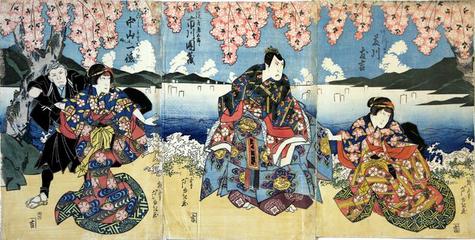Gigadō Ashiyuki (戯画堂芦ゆき) (artist )
Arashi Kano I (あらし加納) as the wife Omatsu (嫁おまつ), Arashi Rikan II (嵐璃寛) as Watanabe Ryosuke (渡辺良助) on the right, Fujikawa Tomokichi II (藤川友吉) as Azuma (あづま) to the left of the previous one, Ichikawa Danzō V (市川団蔵) as Yodoya Tatsugorō (淀屋辰五郎) and Nakayama Ittoku II (中山一徳) as the gentlewoman Otsugi (こしもとおつぎ) on the left, in the play Keisei Yanagizakura [けいせい楊柳桜]
03/1829
10 in x 14.5 in (Overall dimensions) Japanese woodblock print
Signed: Gigadō Ashiyuki ga
戯画堂芦ゆき画
Publishers: Kichi - on each sheet
(Marks U140 seal 06-012)
Honya Seishichi - on left and right
(Marks 123 - seal 25-519)
Lyon Collection - three fresher panels in this collection
Hankyu Culture Foundation - far right panel
Hankyu Culture Foundation - 2nd in from the right
Hankyu Culture Foundation - 2nd in from the left
Hankyu Culture Foundation - far left panel Osaka Prints wrote about this play:
Keisei yanagi zakura (Courtesan, willow, and cherry: けいせい楊桜), which premiered in 1793 at the Naka no Shibai, was the first play in a series of "Yanagizawa dispute plays" (Yanagizawa sōdō mono) to dramatize events about Yanagizawa Yoshiyasu (1658-1714), an exceptionally influential advisor to the fifth shogun, Tokugawa Tsunayoshi (1646-1709). After a successful beginning in governance, Tsunayoshi began to rely on Yanagizawa, a samurai who became Tsunayoshi's most powerful minister for two decades and whom he made a daimyō of Sanuki and Kôfu in 1701. When the shogun's lax rule resulted in a devalued currency and increased taxes, Yanagizawa allowed his personal ambition to sway his judgment, failing to intervene. Tsunayoshi became more erratic and issued shōrui awaremi no rei ("edicts of compassion for living beings"), most notoriously extending protection to dogs and earning him the nickname Inu-kubō ("Dog Shogun"). The end came when the shogun's wife, Mi-Daidokoro, assassinated him and then committed suicide. Yanagizawa was blamed for many of Tsunayoshi's transgressions.****
This four-panel composition was composed to commemorate a performance at the Naka Theater in the third month of 1829.
Although this was at first thought to be an aizuri-e version of

Lyon Collection 3-panel example
****
Illustrated in color in Ikeda Bunko, Kamigata yakusha-e shūsei (Collected Kamigata Actor Prints) Volume 1, Ikeda Bunko Library, Osaka 1997, no. 280, pp. 96-97.
actor prints (yakusha-e - 役者絵) (genre)
Kyōto-Osaka prints (kamigata-e - 上方絵) (genre)
Ichikawa Danzō V (五代目市川団蔵: 4/1819 to 6/1845) (actor)
Arashi Rikan II (二代目嵐璃寛: 9/1828 - 6/1837) (actor)
Fujikawa Tomokichi II (二代目藤川友吉: from 1/1810 to 12/1812 and again from 11/1813 to 10/1815 and again from 11/1819 to 7/1833) (actor)
Nakayama Ittoku II (二代目中山一徳) (actor)
Arashi Kanō I あらし加納 (actor)
![Arashi Kano I (あらし加納) as the wife Omatsu (嫁おまつ), Arashi Rikan II (嵐璃寛) as Watanabe Ryosuke (渡辺良助) on the right, Fujikawa Tomokichi II (藤川友吉) as Azuma (あづま) to the left of the previous one, Ichikawa Danzō V (市川団蔵) as Yodoya Tatsugorō (淀屋辰五郎) and Nakayama Ittoku II (中山一徳) as the gentlewoman Otsugi (こしもとおつぎ) on the left, in the play <i>Keisei Yanagizakura</i> [けいせい楊柳桜]](https://woodblockprint.org/media/lyon_collection/images/8/98013_ca_object_representations_media_817_large.jpg)